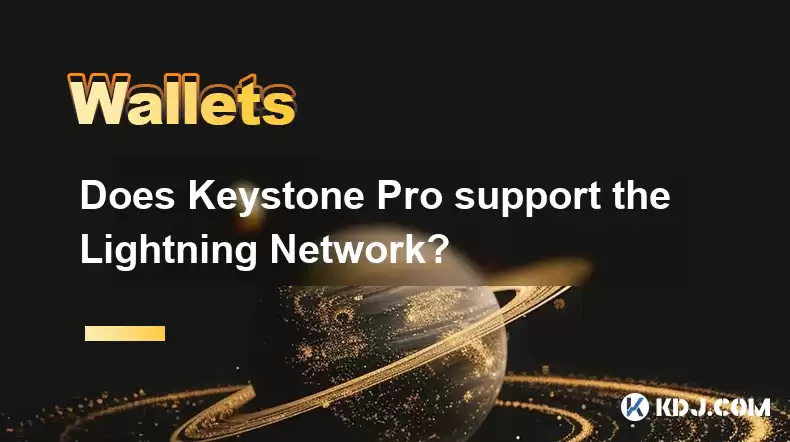-
 Bitcoin
Bitcoin $114400
1.32% -
 Ethereum
Ethereum $3499
2.20% -
 XRP
XRP $2.922
4.26% -
 Tether USDt
Tether USDt $0.0000
0.03% -
 BNB
BNB $752.6
1.53% -
 Solana
Solana $161.8
1.64% -
 USDC
USDC $0.9999
0.01% -
 TRON
TRON $0.3267
1.32% -
 Dogecoin
Dogecoin $0.1991
3.02% -
 Cardano
Cardano $0.7251
3.29% -
 Hyperliquid
Hyperliquid $38.32
3.36% -
 Stellar
Stellar $0.3972
7.58% -
 Sui
Sui $3.437
2.74% -
 Chainlink
Chainlink $16.29
3.65% -
 Bitcoin Cash
Bitcoin Cash $545.3
3.70% -
 Hedera
Hedera $0.2482
7.49% -
 Ethena USDe
Ethena USDe $1.001
0.03% -
 Avalanche
Avalanche $21.40
2.02% -
 Toncoin
Toncoin $3.579
1.56% -
 Litecoin
Litecoin $109.3
2.20% -
 UNUS SED LEO
UNUS SED LEO $8.951
-0.18% -
 Shiba Inu
Shiba Inu $0.00001220
2.75% -
 Polkadot
Polkadot $3.613
2.99% -
 Uniswap
Uniswap $9.173
3.78% -
 Monero
Monero $302.6
2.62% -
 Dai
Dai $0.0000
0.00% -
 Bitget Token
Bitget Token $4.320
1.52% -
 Pepe
Pepe $0.00001048
3.40% -
 Cronos
Cronos $0.1314
4.33% -
 Aave
Aave $259.4
3.54%
Does Keystone Pro support the Lightning Network?
Keystone Pro doesn't support the Lightning Network directly, but users can still use it via compatible software wallets like Electrum or Bluewallet for faster, cheaper Bitcoin transactions.
Apr 24, 2025 at 08:56 pm

Introduction to Keystone Pro
Keystone Pro is a hardware wallet designed to provide secure storage for various cryptocurrencies. It emphasizes user-friendly design and robust security features, making it an appealing choice for both beginners and experienced users in the crypto space. One of the frequently asked questions about Keystone Pro is whether it supports the Lightning Network, a layer-2 solution for Bitcoin that aims to facilitate faster and cheaper transactions.
What is the Lightning Network?
The Lightning Network is a decentralized network using smart contract functionality in the blockchain to enable instant payments across a network of participants. It was created to solve the scalability issues of Bitcoin by allowing transactions to be conducted off the main blockchain, thereby reducing congestion and fees. The Lightning Network operates as a second layer on top of the Bitcoin blockchain, enabling users to open payment channels between each other and conduct multiple transactions without the need to settle them on the blockchain until the channel is closed.
Keystone Pro's Features and Capabilities
Keystone Pro offers a range of features that enhance the security and usability of managing cryptocurrencies. It supports a wide array of cryptocurrencies, including Bitcoin, Ethereum, and various altcoins. The device uses a Secure Element chip to protect private keys, ensuring that they are never exposed to the internet. Additionally, it supports QR code scanning for transaction signing, which adds an extra layer of security by keeping the device offline during transaction processes.
Does Keystone Pro Support the Lightning Network?
As of the latest updates, Keystone Pro does not support the Lightning Network directly. This means users cannot open or manage Lightning Network channels directly through the Keystone Pro hardware wallet. However, this does not mean that users are entirely cut off from using the Lightning Network with their Keystone Pro.
How to Use the Lightning Network with Keystone Pro
Although Keystone Pro does not support the Lightning Network natively, users can still interact with the Lightning Network by using compatible software wallets that support both Lightning Network transactions and hardware wallet integration. Here’s a detailed guide on how to achieve this:
Choose a Compatible Software Wallet: Select a software wallet that supports both the Lightning Network and hardware wallet integration. Examples include Electrum and Bluewallet. Ensure that the wallet you choose is compatible with Keystone Pro.
Set Up the Software Wallet: Download and install the chosen software wallet on your computer or mobile device. Follow the wallet’s setup instructions to create a new wallet or import an existing one.
Connect Keystone Pro to the Software Wallet: Use the software wallet’s interface to connect to your Keystone Pro. This usually involves selecting the "Connect Hardware Wallet" option and following the prompts to establish a connection. Ensure that your Keystone Pro is in the correct mode (usually, you'll need to switch it to "Connect" or "Pair" mode).
Generate a Lightning Network Address: Once connected, use the software wallet to generate a Lightning Network address. This address will be used to receive funds via the Lightning Network.
Fund Your Lightning Network Channel: Transfer Bitcoin from your Keystone Pro to the Lightning Network address you generated. This will open a channel on the Lightning Network, allowing you to send and receive payments.
Conduct Lightning Network Transactions: Use the software wallet to send and receive payments over the Lightning Network. These transactions will be processed off-chain, offering faster and cheaper transactions compared to on-chain Bitcoin transactions.
Close the Lightning Network Channel: When you are done using the Lightning Network, close the channel through the software wallet. This will settle the final balance on the Bitcoin blockchain.
Security Considerations When Using the Lightning Network with Keystone Pro
While using the Lightning Network with Keystone Pro via a software wallet, it’s crucial to consider the security implications. Since the Lightning Network transactions are managed through the software wallet, the security of those transactions depends on the security of the software wallet itself. Ensure that you use a reputable and secure software wallet, keep it updated, and follow best practices for securing your device and internet connection.
Benefits of Using the Lightning Network with Keystone Pro
Even though Keystone Pro does not support the Lightning Network directly, integrating it with a compatible software wallet can still offer significant benefits. Users can enjoy the speed and cost-efficiency of Lightning Network transactions while maintaining the high security provided by Keystone Pro for storing their private keys. This combination allows users to leverage the best of both worlds: the security of a hardware wallet and the scalability of the Lightning Network.
Frequently Asked Questions
Q: Can I use Keystone Pro to open multiple Lightning Network channels?
A: Yes, you can open multiple Lightning Network channels by using a compatible software wallet that supports this feature. Each channel will need to be managed through the software wallet, but the funds can be securely stored on your Keystone Pro.
Q: Is there any risk of losing funds when using the Lightning Network with Keystone Pro?
A: There is always a risk when using any cryptocurrency system, including the Lightning Network. However, by using a reputable software wallet and following best security practices, you can minimize these risks. Always ensure that your software wallet is up to date and that you understand the process of opening and closing Lightning Network channels.
Q: Can I use Keystone Pro with other layer-2 solutions besides the Lightning Network?
A: Keystone Pro's compatibility with other layer-2 solutions depends on the software wallets you use. Some software wallets may support additional layer-2 solutions, allowing you to use them in conjunction with your Keystone Pro. Always check the compatibility of the software wallet with the specific layer-2 solution you are interested in.
Q: How do I ensure that my Keystone Pro remains secure when used with the Lightning Network?
A: To keep your Keystone Pro secure, always use it offline as much as possible, keep the firmware updated, and only connect it to trusted software wallets. Additionally, use strong, unique passwords for your software wallet and enable two-factor authentication where available.
Disclaimer:info@kdj.com
The information provided is not trading advice. kdj.com does not assume any responsibility for any investments made based on the information provided in this article. Cryptocurrencies are highly volatile and it is highly recommended that you invest with caution after thorough research!
If you believe that the content used on this website infringes your copyright, please contact us immediately (info@kdj.com) and we will delete it promptly.
- Kaspa, HBAR, and Cold Wallet: A New York Minute on Crypto's Latest Moves
- 2025-08-04 09:11:54
- Ethereum Whale Watch: Selling Pressure and Price Volatility
- 2025-08-04 09:11:54
- XRP ETF Mania: Teucrium's Crypto Triumph and the Altcoin Frenzy
- 2025-08-04 09:30:13
- Crypto Wallet Scam: A $900K Loss & What You Need to Know
- 2025-08-04 09:35:13
- Dogecoin's Wild Ride: Elliott Wave, Stochastic RSI, and What's Next, Ya Know?
- 2025-08-04 09:40:12
- Shiba Inu (SHIB), Crypto Investments, and the Meme Coin Evolution: What's the Deal?
- 2025-08-04 09:45:17
Related knowledge

What is a watch-only wallet in Trust Wallet?
Aug 02,2025 at 03:36am
Understanding the Concept of a Watch-Only WalletA watch-only wallet in Trust Wallet allows users to monitor a cryptocurrency address without having ac...

How to fix a stuck pending transaction in Trust Wallet?
Aug 03,2025 at 06:14am
Understanding Why Transactions Get Stuck in Trust WalletWhen using Trust Wallet, users may occasionally encounter a pending transaction that appears t...

What is a multi-coin wallet in Trust Wallet?
Aug 03,2025 at 04:43am
Understanding Multi-Coin Wallets in Trust WalletA multi-coin wallet in Trust Wallet refers to a digital wallet that supports multiple cryptocurrencies...

How to switch between networks in Trust Wallet?
Aug 02,2025 at 12:36pm
Understanding Network Switching in Trust WalletSwitching between networks in Trust Wallet allows users to manage assets across different blockchains s...

How to check my full transaction history on Trust Wallet?
Aug 02,2025 at 09:24am
Understanding Transaction History in Trust WalletTrust Wallet is a widely used non-custodial cryptocurrency wallet that supports a broad range of bloc...

What are gas fees in Trust Wallet?
Aug 04,2025 at 06:14am
Understanding Gas Fees in Trust WalletGas fees in Trust Wallet refer to the transaction costs required to execute operations on a blockchain network. ...

What is a watch-only wallet in Trust Wallet?
Aug 02,2025 at 03:36am
Understanding the Concept of a Watch-Only WalletA watch-only wallet in Trust Wallet allows users to monitor a cryptocurrency address without having ac...

How to fix a stuck pending transaction in Trust Wallet?
Aug 03,2025 at 06:14am
Understanding Why Transactions Get Stuck in Trust WalletWhen using Trust Wallet, users may occasionally encounter a pending transaction that appears t...

What is a multi-coin wallet in Trust Wallet?
Aug 03,2025 at 04:43am
Understanding Multi-Coin Wallets in Trust WalletA multi-coin wallet in Trust Wallet refers to a digital wallet that supports multiple cryptocurrencies...

How to switch between networks in Trust Wallet?
Aug 02,2025 at 12:36pm
Understanding Network Switching in Trust WalletSwitching between networks in Trust Wallet allows users to manage assets across different blockchains s...

How to check my full transaction history on Trust Wallet?
Aug 02,2025 at 09:24am
Understanding Transaction History in Trust WalletTrust Wallet is a widely used non-custodial cryptocurrency wallet that supports a broad range of bloc...

What are gas fees in Trust Wallet?
Aug 04,2025 at 06:14am
Understanding Gas Fees in Trust WalletGas fees in Trust Wallet refer to the transaction costs required to execute operations on a blockchain network. ...
See all articles

























































































